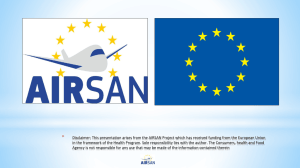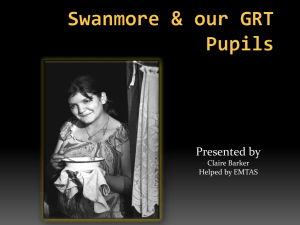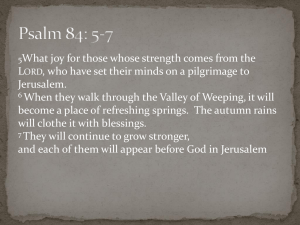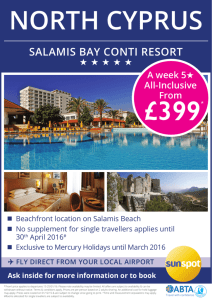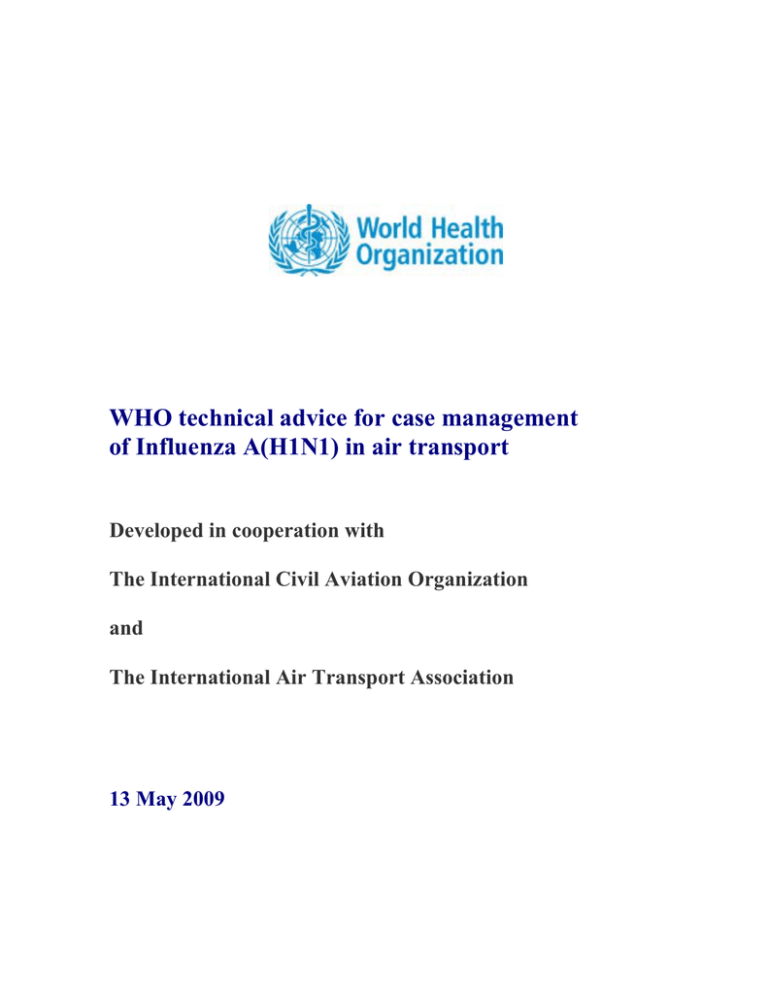
WHO technical advice for case management
of Influenza A(H1N1) in air transport
Developed in cooperation with
The International Civil Aviation Organization
and
The International Air Transport Association
13 May 2009
ii
Contents
I. Introduction...................................................................................................................................................................1
II. Management of events during the flight.....................................................................................................................3
III. Action by public health authority/competent authority at arrival airport.................................................................7
IV. Arrival airport – additional information..................................................................................................................10
V. General requirements when applying health measures to international travellers — IHR (2005) .........................12
References ......................................................................................................................................................................13
Annex 1 — Passenger Locator Card .............................................................................................................................15
Annex 2 - Health Part of Aircraft General Declaration, IHR Annex 9 ........................................................................16
Annex 3 - Handwashing Procedures .............................................................................................................................17
iii
© World Health Organization 2009
All rights reserved.
The designations employed and the presentation of the material in this publication do not imply the
expression of any opinion whatsoever on the part of the World Health Organization concerning the legal
status of any country, territory, city or area or of its authorities, or concerning the delimitation of its frontiers
or boundaries. Dotted lines on maps represent approximate border lines for which there may not yet be full
agreement.
The mention of specific companies or of certain manufacturers’ products does not imply that they are
endorsed or recommended by the World Health Organization in preference to others of a similar nature that
are not mentioned. Errors and omissions excepted, the names of proprietary products are distinguished by
initial capital letters.
All reasonable precautions have been taken by the World Health Organization to verify the information
contained in this publication. However, the published material is being distributed without warranty of any
kind, either expressed or implied. The responsibility for the interpretation and use of the material lies with
the reader. In no event shall the World Health Organization be liable for damages arising from its use.
Acknowledgements
This document is the product of collaborative efforts across WHO, led by the
International Health Regulations Coordination Department and the Task Force for the
Influenza A(H1N1) Response at WHO and in collaboration with International Civil
Aviation Organization (ICAO) and International Air Transport Association (IATA).
WHO wishes to acknowledge with gratitude the commitment of experts from ICAO,
IATA and staff who contributed to the preparation of this document, particularly
Dr Anthony Evans, Chief of Aviation Medicine Section, ICAO, Montreal, Canada, and
Dr Claude Thibeault, Consultant to IATA, Montreal, Canada.
Declarations of interest were obtained from the above major contributors. For the
contributor with a potential conflict of interest, information is provided in the footnote
below.1
This document has been developed to meet the urgent need for guidance and the
recommendations are only valid until new guidance becomes available, at the latest
until the end of 2009.
1
Declared interest: Dr Claude Thibeault: Medical Adviser, Consultant to IATA.
iv
I. Introduction
This document is part of a series of guidance documents that is being produced by the World
Health Organization (WHO) in response to the “public health emergency of international
concern” related to the new influenza A(H1N1), as determined by the WHO Director-General
on 25 April 2009. These documents are being updated regularly and can be accessed on the
WHO web site2.
The target audience for this guidance document includes the National Focal Points for the
International Health Regulations (IHR (2005))(1) and competent national public health
authorities at points of entry, as well as airport operators, aircraft operators, airport personnel,
crew members and other stakeholders involved in air transport.
With the adoption of the IHR (2005) by the World Health Assembly in May 2005, States
Parties agreed to develop, strengthen and maintain the capacities related to surveillance,
reporting, notification, verification, response and collaboration, including activities concerning
points of entry. These include contingency plans for public health emergencies that aim at
preventing public health risks from spreading internationally, while avoiding unnecessary
interference with international traffic and trade. States Parties also have obligations concerning
application of health measures to international travellers, trade and transportation, surveillance
and reporting to WHO, public health response and other areas.
A group of internal and external experts was convened to develop emergency guidance on case
management of the new Influenza A(H1N1) in air transport. This technical advisory group was
composed of professionals with expertise and experience in the areas of aviation medicine,
hygiene and sanitation in aviation, occupational health, in infection, prevention and disease
control. The recommendations have been developed to provide urgent guidance to countries to
reduce human exposure3 to infectious agents at airports and during air travel, and to improve
the response to health-related emergencies by establishing mechanisms for rapid intervention,
especially when suspected cases of the new influenza A(H1N1) are detected in flight.
This document was developed after a review of existing relevant WHO guidelines for air
travel and health (2-4), relevant guidance documents on influenza preparedness and response
(5-9), and available guidance on the current influenza A(H1N1) outbreak 4 and other
documents (10-15) that provided international and national guidance related to air travel and
health, as well as through consideration and discussion of expert opinions.
2
See: WHO Epidemic Alert and Response Web page on Influenza A(H1N1). Available at:
http//:www.who.int/csr/disease/swineflu/en/index.html
3
Exposure is defined as proximity and/or contact with a source of a disease agent in such a manner that effective
transmission of the agent may occur. For influenza the main route of transmission is by droplets propelled over
short distances and which contaminate surfaces; transmission may occur at short distances through inhalation of
small-particle aerosols (droplet nuclei), particularly in shared air spaces.
4
See: References section, p. 17.
1
Opinion, experience, and draft recommendations were considered by the expert group during
several meetings at WHO Headquarters, Geneva, from 27 April to 6 May 2009. Experts from
WHO, the International Civil Aviation Organization (ICAO) and the International Air
Transport Association (IATA) evaluated the comments suggested by the experts providing
guidance when opinions differed, and providing oversight regarding the incorporation of
amendments and finalization of the document. Recommendations were reviewed and finalized
on 7 May 2009.
This document compiles recommendations from existing guidelines for air travel and health as
well as specific WHO guidelines related to influenza A(H1N1), where applicable for air
transport, and outlines some measures to be taken by aircraft operators, airport operators
airport personnel, crew members and national authorities. It can be used in conjunction with
the document Guide to Hygiene and Sanitation in Aviation, 3rd edition 5. Useful guidance
related to this subject is also available from the web sites of the International Civil Aviation
Organization (http://www.icao.int) and International Air Transport Association (www.iata.org).
The guidance in this document should be adapted to the local situation, the national and
international regulations, and guidelines provided in national pandemic preparedness plans.
Mainly it addresses aspects in relation to first aid in flight and at airports, and it supports
contingency planning to control public health risk and avoid unnecessary interference with
international traffic and trade. It is not intended to address all public health issues and related
rules and regulations that may arise in relation to aircraft or airport operations.
The use of this document should result in greater predictability of the measures adopted by the
various stakeholders (including both public and private sector entities), and facilitate
implementation of appropriate actions in suspected cases of the new influenza A(H1N1).
5
See: Guide to Hygiene and Sanitation in Aviation, 2009. Geneva: World Health Organization. Available at:
http://www.who.int/water_sanitation_health/hygiene/ships/en/
2
II. Management of events during the flight
This part of the document provides a basic framework of response for cabin crew members to
help them manage a person with influenza-like symptoms in order to reduce potential
transmission on board and to prepare follow-up actions with airport operators and local public
health authorities at destination.
The likelihood that a person is suffering a communicable disease is increased if he/she has a
fever with a temperature of 38 °C/100 °F or greater, associated with one or more of the
following signs or symptoms, e.g. appearing obviously unwell; persistent coughing; impaired
breathing; persistent diarrhoea; persistent vomiting; skin rash; bruising or bleeding without
previous injury; or confusion of recent onset. In the current situation, the cabin crew should
also consider as suspicious any traveller with a fever and one of the influenza-like signs and
symptoms (fever, cough, headache, body aches, sore throat, runny nose and sometimes
vomiting or diarrhoea).
Cabin crew member actions
Persons on board who may be suffering from a communicable disease, especially if they have
influenza-like signs and symptoms, should receive immediate attention. Further advice for
cabin crew members is described in Box 1.
3
Box 1: Recommended procedures for cabin crew members 1.
2.
3.
4.
5.
If medical support from the ground is available, contact ground support immediately and/or page for medical assistance on board (as per company policy). If medical ground support and/or an on‐board health professional is available, crew should follow their medical advice accordingly. If no medical support is available: a) Relocate the ill traveller to a more isolated area, if appropriate, and space is available. If the ill traveller is relocated, make sure that the cleaning crew at destination will be advised to clean both locations. (All surfaces potentially contaminated by the ill traveller should be cleaned and disinfected according to the WHO Guide to Hygiene and Sanitation in Aviation) *. b) Designate one cabin crew member to look after the ill traveller, preferably the cabin crew member who has already been dealing with this traveller. More than one cabin crew member may be necessary if more care is required. c) When possible, designate a specific lavatory for the exclusive use of the ill traveller. If not possible, the commonly touched surfaces of the lavatories (faucet, door handles, waste‐bin cover, counter top, etc.) must be cleaned and disinfected after each use by the ill traveller. d) If the ill traveller is coughing, request him/her to follow respiratory etiquette: i. Provide tissues and the advice to use the tissues to cover the mouth and nose when speaking, sneezing or coughing. ii. Advise the ill traveller to practice proper hand hygiene**. If the hands become visibly soiled, they must be washed with soap and water. iii. Provide an air‐sick bag to be used for the safe disposal of tissues. e) If available on aircraft and tolerated by the ill traveller, a medical (surgical or procedure) mask should be, and the ill traveller asked to wear it. If a mask is used, replace with a new mask as soon as it becomes damp/humid. After touching a used mask, (e.g., for disposal), proper hand hygiene* must be practised immediately. Single masks should not be reused and must be disposed safely after use. f) If there is a risk of direct contact with body fluids, the crew member should wear disposable gloves. *
Gloves are not intended to replace proper hand hygiene . Gloves should be carefully removed and safely disposed. After the removal of gloves, hands should preferably be washed with soap and water or, if the hands are not visibly soiled, cleansed with an alcohol‐based hand rub. g) If the ill traveller cannot tolerate a mask, the designated cabin crew member(s) or any other person in close contact (less than 1 metre) with the ill person should wear a medical (surgical or procedure) mask. The airline should ensure that the cabin crew member has adequate training in its use to ensure that risk is not increased (for example by more frequent hand‐face contact or adjusting and removing the mask). h) Store soiled items (used tissues, disposable masks, oxygen mask and tubing, linen, pillows, blankets, seat pocket items, etc.) in a biohazard bag if one is available. If not, use a sealed plastic bag and label it “biohazard”. i) Ask accompanying traveller(s) (spouse, children, friends, etc.) if they have any similar symptoms. The same procedure should be followed for all ill travellers. j) Ensure that hand‐carried cabin baggage is removed along with the ill traveller, and comply with any public health authority requests. As soon as possible, advise the captain of the situation. Unless stated otherwise by ground medical support or public health officials, ask all travellers seated in the same row, and two rows in front and two rows behind the ill traveller (i.e. a total of five rows) to complete a passenger locator card (according to the model provided in Annex 1 (available at http://www.who.int/ihr/PLC.pdf ) if such cards are available on the aircraft. If not available on board, this action should be taken immediately upon the arrival of the aircraft at next airport. For further information of operational procedures recommended by IATA, please see IATA Guidelines for Cabin Crew: http://www.iata.org/NR/rdonlyres/DD29D97F‐0E8C‐4CBD‐B575‐1F5067174941/0/Guidelines_cabin_crew_finalDec2008.pdf * Guide to Hygiene and Sanitation in Aviation, revised draft 2009. Geneva: World Health Organization. Available at: http://www.who.int/water_sanitation_health/hygiene/ships/en/ ** Proper hand hygiene: A general term referring to any action of hand cleansing, performed by washing one’s hands (either with soap and water or an antiseptic hand rub) for at least 15 seconds. Touching the face with hands should be avoided (see Appendix 3). 4
Pilot in command actions
The pilot in command of an aircraft may take such emergency measures in flight as may be
necessary for the health and safety of travellers on board. The event needs also to be recorded
on the Health Part of the Aircraft General Declaration, IHR Annex 9.6
He/she shall inform air traffic control, as early as possible before arrival, of any cases of illness
indicative of a disease of an infectious nature or evidence of a public health risk on board. This
information must be relayed immediately/as soon as possible by air traffic control to the
competent authority for the destination airport, according to procedures established in IHR
(2005), Article 28.4 and ICAO Procedures for Air Navigation Services – Air Traffic
Management (PANS-ATM, Document ICAO PANS-ATM 16.6), as described in Figure 1 and
in Box 2.
Figure 1 Air traffic control (ATC) notification of an event
ATC NOTIFICATION OF EVENT
AIRPORT
OPERATOR
PHA
OTHER
AGENCY
AIRLINE
OPERATING
AGENCY
En route ATC
Aerodrome tower
In summary:
(1)
(2)
(3)
(4)
Pilot reports to air traffic services (ATS)
ATS reports to destination (and departure) ATS unit
Destination ATS unit reports to public health authority/competent authority for the airport
Public health authority (PHA)/competent authority contacts airline operating agency to
obtain further details of illness
The specific mechanisms for implementing communications between the competent authority,
airline operating agency and airport/aerodrome authority (items 3 and 4 above) are determined
nationally.
6
International Health Regulations (2005), 2nd edition. Geneva: World Health Organization; 2008. Available at:
http://whqlibdoc.who.int/publications/2008/9789241580410_eng.pdf
5
Box 2: PANS‐ATM 16.6*: The flight crew of an en‐route aircraft shall, upon identifying a suspected case(s) of communicable disease, or other public health risk, on board the aircraft, promptly notify the Air Traffic Service (ATS) unit with which the pilot is communicating, the information listed below: (a) aircraft identification; (b) departure aerodrome; (c) destination aerodrome; (d) estimated time of arrival; (e) number of persons on board; (f) number of suspected case(s) on board; and (g) nature of the public health risk, if known. _________________________________________________________ 16.6.2 The ATS unit, upon receipt of information from a pilot regarding suspected case(s) of communicable disease, or other public health risk on board the aircraft, shall forward a message as soon as possible to the ATS unit serving the destination/departure, unless procedures exist to notify the appropriate authority designated by the State, and the aircraft operator or its designated representative. 16.6.3 When a report of a suspected case(s) of communicable disease, or other public health risk, on board an aircraft is received by an ATS unit serving the destination/departure, from another ATS unit or from an aircraft or an aircraft operator, the unit concerned shall forward a message as soon as possible to the public health authority (PHA) or the appropriate authority designated by the State as well as the aircraft operator or its designated representative, and the aerodrome authority. Note 1. For relevant additional information related to the subject of communicable disease and public health risk on board an aircraft, see The International Civil Aviation Convention, Annex 9, Chapter 1 (Definitions), Chapter 8, 8.12 and 8.15, and Appendix 1, Note 2. The PHA is expected to contact the airline representative or operating agency and aerodrome authority, if applicable, for subsequent coordination with the aircraft concerning clinical details and aerodrome preparation. Depending on the communications facilities available to the airline representative or operating agency, it may not be possible to communicate with the aircraft until it is closer to its destination. Apart from the initial notification to the ATS unit whilst en‐route, air traffic control communications channels are to be avoided. Note 3. The information to be provided to the departure aerodrome will prevent the potential spread of communicable disease, or other public health risk, through other aircraft departing from the same aerodrome. Note 4. AFTN** (urgency message), telephone, facsimile or other means of communication may be used. * Although not formally applicable until November 2009, its immediate implementation is advised. ** AFTN: Aeronautical Fixed Telecommunications Network i.e. ground‐based telecommunications network 6
III. Action by public health authority/competent authority at
arrival airport
To effectively manage a public health event on board an aircraft, and to minimize the adverse
effect of such events on travellers and airport operations, the relevant competent authority 7
shall take action according to the national public health surveillance and response procedures,
the airport emergency plan regarding public health events and international requirements,
addressing the following issues among others8:
(1) Coordinate with the airport operator/airport authority to provide a parking area for the
aircraft.
(2) Coordinate with airport authorities to grant credentials and security escorts to public
health personnel and emergency responders who require access to restricted areas of the
airport.
(3) Make appropriate notifications about the incident.
(4) Facilitate and supervise the implementation of arrangements, including agreements or
memoranda of understanding with appropriate agencies, health care units, airport
authorities, airlines and service providers, for the management of arriving traveller(s)
displaying symptoms of a disease of concern, including coordination for customs and
immigration clearance.
(5) Ensure availability of appropriate transport for travellers suspected of having an illness
of public health concern to a designated facility for further evaluation, quarantine,
isolation and treatment as necessary.
(6) Work with other local health authorities, medical services and other agencies to assist in
the care of passengers and crew if they are housed at a temporary health care facility or
quarantine facility, preferably away from the airport.
(7) Conduct further public health risk assessment relating to the arrival and departure of ill
or suspect travellers. Consideration should be given to disease-specific local protocols
where appropriate, and assessment should be undertaken at the earliest possible
opportunity following disembarkation from the conveyance.
(8) Establish with airport operators an appropriate area(s) for undertaking health
assessment of traveller(s) with symptoms of a disease of concern. This area(s) should
accommodate appropriate numbers of traveller(s) and allow privacy, provide good
ambient light, appropriate ventilation, access to designated toilet facilities and
telecommunications.
(9) Coordinate with customs, immigration and other federal partners, for adequate
clearance of travellers, baggage, personal items, etc.
7
“Competent authority” means an authority responsible for the implementation and application of health measures
under the International Health Regulations (2005).
8
See Box 3 for specific checklist for arriving or departing ill travellers (including crew members),
7
(10) Establish a communication strategy that educates and informs in a timely manner
relevant agencies, the airport operator, aircraft operators and service providers of their
obligations as specified in the contingency plan. Aircraft operators and other service
providers, agencies and authorities should be advised of public health measures to be
applied at arrival and departure, in response to occurrences of a disease of concern.
(11) Ensure that aircraft operators inform travellers of the health measures recommended by
WHO and adopted by the State Party for application on board and assist with providing
information to family and friends of passengers and crew, as appropriate.
(12) Establish a system whereby all relevant health authorities and border agency
representatives are appropriately trained in traveller health assessment and
management, according to their duties and competences, including use of and access to
personnel protective equipment (PPE).
(13) Establish a system that enables the identification of at-risk traveller(s) who have
travelled on aircraft where cases of a disease of concern are suspected or have been
confirmed for future contact tracing, if applicable, in accordance with data protection
requirements.
(14) Assist with logistics, as applicable.
(15) Ensure that travellers are treated in accordance with national law and international
requirements (including the International Health Regulations (2005)).
Local airline agents should be informed of the Public Health Response Plan, including
information about designated facilities, and have local procedures integrated into their own
protocols.
Public health officers need to have quick and efficient access to the aircraft, using appropriate
PPE and hand-hygiene supplies. For many communicable diseases, disposable gloves and good
hand hygiene (at times in combination with medical masks) are sufficient unless otherwise
specified by the national public health authority.
A traveller having a communicable respiratory disease should wear a mask unless the traveller
is unable to tolerate it. If a mask is worn consistently by the ill traveller this precludes the
need for others to wear a mask. All disposable materials in potential contact with an ill
traveller need to be removed using biohazard precautions.
All surfaces potentially contaminated by the ill traveller should be cleaned and disinfected
according to the WHO Guide to Hygiene and Sanitation in Aviation.9
An ill traveller should be taken by a medical escort from the aircraft to an area suitable for
further assessment/treatment. Appropriate infection control measures should be applied. Before
disembarkation, travellers and crew on the same aircraft as the ill traveller should remain
segregated from other travellers until traveller seating details, contact details and destination
have been obtained and they have been advised by public health authority staff of any
necessary preventive measures.
9
8
See footnote 5.
Procedures need to be in place for obtaining baggage, customs and security clearance of an ill
traveller, and others accompanying him/her.
A procedure for transporting an ill traveller to hospital needs to be in place.
Box 4: Checklist for arriving or departing ill travellers (including crew members) a.
Are systems in place, on departure, en‐route, or on arrival, for management of travellers reported as displaying symptoms suggestive of influenza? b. Are systems in place to ensure that any reports of arriving travellers displaying symptoms suggestive of influenza are accurately and immediately relayed to the public health authority at the intended place of arrival? c. Are systems in place to alert the National IHR Focal Point, should ill travellers arrive with symptoms suggestive of a condition that could be related to this public health event (or other applicable events)? d. Are systems in place for the identification and contact tracing of various categories of fellow travellers depending on the suspected illness, as applicable, in accordance with the national and international requirements? e. Are agreements in place with relevant agencies for: the management of travellers displaying symptoms suggestive of influenza, including initial medical assessment of the ill traveller; assessment of associated public health risks; expediting of clearance procedures etc.? f. Are agreements in place with the relevant agencies for the transportation of travellers displaying symptoms suggestive of influenza from the airport of entry to the designated health care facility/facilities, and for the delivery of the relevant medical examination and treatment, as well as access to diagnostic capability in the designated health care facility/facilities. g. Are arrangements in place for public health responders to have access through secure areas of the airports to respond to reports of arriving or departing travellers displaying symptoms suggestive of a communicable disease, should that be required? h. Are arrangements in place with other border agencies for the clearance of ill travellers, those accompanying ill travellers, and their baggage, being transported to health care facilities? i. Is there a designated area that will allow privacy, with good ambient light, ventilation, easy cleaning, and access to designated toilet facilities and telecommunications for the assessment where necessary of small groups of suspect travellers? j. Are areas designated at the airport for the assessment and management of various categories of fellow travellers (e.g. family members, others in travel group, those sitting near to the ill person, entire aircraft occupants) should the need arise due to the suspected illness of the ill traveller? k. Do contingency plans at the airport include the potential need to separate suspect travellers from others in the airport until given public health clearance? l. Do contingency plans at the port of entry include the possibility of moving suspect travellers to designated health care facilities away from the airport for assessment, treatment, isolation, or quarantine, as appropriate? Does the existing procedure ensure minimal contact with others, until such time as the risk of their carrying such disease has been dismissed or managed? m. Do contingency plans include the provision of language interpretation services if required? n. Do contingency plans include media communication strategies, as applicable, for the event of an ill person arriving with a suspected communicable disease, the nature of which could raise public concern? o. Are systems in place for the collection, management and use of contact‐tracing information, to allow for rapid contact with fellow travellers post‐clearance, should that be required due to the eventual diagnosis of the ill traveller? p. Are public health response stockpiles available for rapid response at the airport, e.g. personal protective equipment (e.g. masks and gloves), documentation, passenger locator cards, etc.? q. Are systems in place to ensure the cleaning and disinfection of conveyances, and any contaminated airport spaces if required? 9
IV. Arrival airport – additional information
Parking position of aircraft
The pilot in command (PIC) needs to be advised where to park the aircraft – such information
will normally be communicated to the PIC by air traffic control. The decision will usually be
taken by the public health authority in consultation with airline and airport authorities. This
may be on a remote stand or, depending on the situation, on the apron with or without an air
bridge attached. It should be noted that parking an aircraft some distance away from the
terminal building is likely to delay the public health assessment of the situation, and may make
passenger handling more complicated. There is no evidence to suggest that the public health
risk is greater if the aircraft is parked adjacent to the terminal, with an air bridge or steps used
for disembarkation. In principle, the aircraft arrival should be managed by a system that is as
close to routine as possible: using a remote stand is not mandatory.
Aircrew and ground crew need to be advised concerning the opening of aircraft doors,
disembarkation and the information to be given to travellers prior to the arrival of the medical
team.
Action should be taken to disembark the travellers as soon as possible after the situation has
been evaluated and a public health response has been instituted, if needed.
Disembarkation of travellers
At the arrival airport all travellers on the aircraft should follow national public health
procedures regarding the need for health information (including completion of passenger
locator cards or other documents) and further checks.
It is recommended that completed passenger locator cards be collected from travellers seated in
the same row, two rows in front and two rows behind the ill traveller (i.e. a total of five rows).
If such cards are not available on the aircraft they should be provided (according to model
provided in Appendix 110) and completed at the arrival airport in order that travellers may be
located at a later date by public health authorities.
In addition, other fellow travellers who may have been seated beyond the two rows in front and
two rows behind, but nevertheless had close contact with ill passenger during this travel —
such as family members, other members of a travel group, or having cared for, lived with, or
had direct contact with respiratory secretions or body fluids of a probable or confirmed case of
influenza A(H1N1), as well the ill person — may be required to provide information
concerning their destination in case they may need to be contacted, according to the national
pandemic preparedness plan.
10
Passenger Locator Card. Available at: http://www.who.int/ihr/PLC.pdf
10
Close contacts identification and follow-up
The travellers must be informed that if any symptoms and signs of influenza-like illness (fever,
cough, headache, body aches, sore throat, runny nose and sometimes include vomiting or
diarrhoea) develop within the next 7 days, they should seek medical help and inform the health
care provider about his/her travel history.
Occupational health of airline crew members
Airline crew members may be exposed to travellers infected with the influenza A(H1N1)
virus.They should follow the (same) practices and instructions described above.
Routine infection prevention and control, such as hand hygiene and control of the source of
infection through social distancing and cough etiquette (including wearing of masks by
symptomatic individuals) are important control measures and should be followed by the crew if
they are symptomatic.
Recommendations are based on standard infection control and industrial hygiene practices.
Rapid implementation of these measures can help to ensure protection of airline crew members
and travellers and help limit the potential spread of the virus through airline travel.
Management of crew-member exposure following completion of flight
Crew members who may have been exposed to a traveller suspected of having influenza
A(H1N1) should monitor their health for 7 days following the exposure. They can continue to
work as per their original schedule unless they become ill with influenza-like symptoms.
If they do become ill with influenza-like symptoms, including fever, cough, headache, body
aches, sore throat, runny nose and sometimes include vomiting or diarrhoea, they should
immediately take the following steps:
•
•
•
•
•
•
•
Stay at home except to seek medical care; do not report to work.
Notify their employer.
Contact their occupational health service or personal physician.
Inform the occupational health service, clinic, or emergency room before visiting it
about the possible exposure to influenza.
Do not travel, unless it is critical to travel locally for health care.
Limit contact with others as much as possible.
When not alone or in a public place, wear a facemask to reduce the number of droplets
coughed or sneezed into the air.
11
Cleaning and disinfection
Cleaning refers to the removal of visible dirt or particles, while disinfection refers to the
measures taken to control, deactivate or kill infectious agents such as viruses and bacteria.
Cleaning and disinfection on aircraft require special attention since it is necessary to use agents
that are not corrosive or otherwise detrimental to aircraft components. It is therefore necessary
to exercise caution in selecting suitable products and before applying them in the cabin. In
addition, manufacturers’ instructions must be followed carefully to protect the health of the
cleaning personnel and to ensure effective action.
Cleaning crews need to be adequately trained for routine cleaning and disinfection procedures
and also for those to be implemented following a communicable disease event, since the
requirements are likely to differ. Exposure to body fluids (such as respiratory secretions or
blood), vomit or faeces may involve a risk of infection if not properly contained. Cleaning
crews therefore need to follow the procedures that will ensure effective cleaning and
disinfection and protect their health, using appropriate personal protective equipment.
For more detailed technical guidance see the Guide to Hygiene and Sanitation in Aviation.11
V. General requirements when applying health measures to
international travellers — IHR (2005)
1. Travellers must be treated:
a. With courtesy, and respect for their dignity, human rights and fundamental
freedoms;
b. So as to minimize any discomfort or distress associated with these measures;
and
c. Taking into account their gender, sociological, ethnic and religious concerns
2. Where international travellers are subject to health measures such as quarantine,
isolation or medical examinations12 or other public health procedures, the State must
provide or arrange for:
a. Adequate food and water.
11
Guide to Hygiene and Sanitation in Aviation, revised draft 2009. Geneva: World Health Organization.
Available at: http://www.who.int/water_sanitation_health/gdwqrevision/aviation/en/index.html .
12
“Medical examination” means a preliminary assessment to determine health status and potential risk to others,
and may include scrutiny of health documents, and a physical exam when justified by circumstances of the
individual case (see IHR (2005) Article 1, Definitions).
12
b. Appropriate accommodation and clothing.
c. Protection for baggage and possessions.
d. Appropriate medical treatment.
e. Means of necessary communication.
f. Other appropriate assistance ((IHR (2005), Article 32).
3. Measures must be initiated and completed without delay, and applied in a transparent
and non-discriminatory manner ((IHR (2005), Article 42).
4. All medical examinations, procedures, vaccination, other prophylaxis for travellers
which involves risk of disease transmission must be performed or administered in
accordance with established national/international safety guidelines/standards to
minimize that risk ((IHR (2005), Article 23.5).
Charges to travellers for health measures — IHR (2005)
1. Unless travellers are seeking temporary or permanent residence, no charges shall be
made for the following measures primarily for the protection of public health:
a. Any medical examination under the Regulations, or any supplementary
examination required by the State to ascertain the health status of the traveller.
b. Isolation or quarantine requirements.
c. Certificates issued to the traveller specifying the measures applied and date.
d. Health measures applied to accompanying baggage.
e. Any vaccination or prophylaxis provided to travellers on arrival unless the
requirement was published at least 10 days before arrival.
2. For charges to travellers for other health measures:
a. Each State must have just one tariff (and all charges must conform to this tariff).
b. The tariff may not exceed the actual cost of the service.
c. There may not be discrimination as to nationality, domicile or residence of
travellers.
d. The tariff must be published at least 10 days earlier ((IHR (2005), Article 40).
Travellers or conveyance operators may not be stopped from leaving the State pending
payment of these charges.
The IHR (2005) do not preclude States from seeking reimbursement for these expenses
listed under paragraph 1, above, from insurance sources or from conveyance owners or
operators as to their employees.
References
1.
International Health Regulations (2005), 2nd edition. Geneva: World Health Organization; 2008. Available at:
http://www.who.int/ihr/9789241596664/en/index.html
2.
Guide to Hygiene and Sanitation in Aviation, revised draft 2009, Geneva: World Health Organization.
Available at: http://www.who.int/water_sanitation_health/hygiene/ships/en/
13
3.
Tuberculosis and Air Travel - Guidelines for Prevention and Control, 3rd edition. Geneva: World Health
Organization; 2008. Available at:
http://www.who.int/tb/publications/2008/WHO_HTM_TB_2008.399_eng.pdf
4.
Global Surveillance during an Influenza Pandemic. Geneva: World Health Organization; 2009. Available at:
http://www.who.int/csr/disease/swineflu/global_pandemic_influenza_surveilance_apr09.pdf
5.
Pandemic Influenza Preparedness and Response – a WHO Guidance Document. Geneva: World Health
Organization; 2009. Available at: http://www.who.int/csr/disease/influenza/PIPGuidance09.pdf
6.
Advice on the use of masks in the community setting in Influenza A (H1N1) outbreaks: Interim guidance.
Geneva: World Health Organization; 2009. Available at:
http://www.who.int/csr/resources/publications/swineflu/masks_community/en/index.html
7.
Infection prevention and control in health care in providing care for confirmed or suspected A(H1N1) swine
influenza patients. Geneva: World Health Organization; 2009. Available at:
http://www.who.int/csr/resources/publications/20090429_infection_control_en.pdf
8.
Interim WHO guidance for the surveillance of human infection with swine influenza A(H1N1) virus. Geneva:
World Health Organization; 2009. Available at:
http://www.who.int/csr/resources/publications/swineflu/interim_guidance/en/index.html
9.
Infection prevention and control of epidemic- and pandemic-prone acute respiratory diseases in health care.
Geneva: World Health Organization; 2007. Available at:
http://www.who.int/csr/resources/publications/WHO_CDS_EPR_2007_6c.pdf
10. Facilitation: Annex 9 to the Convention on International Civil Aviation. Montreal: International Civil
Aviation Organization, 2007. Available at: http://www.icao.int/eshop/pub/anx_info/an09_info_en.pdf
11. Guidelines for States Concerning the Management of Communicable Disease Posing a Serious Public Health
Risk. Montreal: International Civil Aviation Organization; 2009. Available at:
http://www.icao.int/icao/en/med/guidelines.htm
12. General Guidelines for Cabin Crew, Suspected Communicable Disease, International Air Transport
Association, 2008, http://www.iata.org/NR/rdonlyres/DD29D97F-0E8C-4CBD-B5751F5067174941/0/Guidelines_cabin_crew_finalDec2008.pdf
13. Interim Guidance for Airlines Regarding Flight Crews Arriving from Domestic and International Areas
Affected by Swine Influenza. Atlanta: Centers for Disease Control and Prevention; 2009. Available at:
http://www.cdc.gov/h1n1flu/guidance/air-crew-dom-intl.htm
14. Clean hands protect against infection. Geneva. World Health Organization. Available at:
http://www.who.int/gpsc/clean_hands_protection/en/index.html
15. A Dictionary of Epidemiology, 4th edition. Edited by John M. Last. Oxford: Oxford University Press; 2001.
14
Annex 1 — Passenger Locator Card13
Public Health Passenger Locator Card to be completed when public health authorities suspect the presence of a communicable disease. The
information you provide will assist the public health authorities to manage the public health event by enabling them to trace passengers who
may have been exposed to communicable disease. The information is intended to be held by the public health authorities in accordance with
applicable law and to be used only for public health purposes.
13
Passenger Locator Card. See footnote 7.
15
Annex 2 - Health Part of Aircraft General Declaration, IHR Annex 914
Health Part of Aircraft General Declaration, IHR Annex 9 ANNEX 9 THIS DOCUMENT IS PART OF THE AIRCRAFT GENERAL DECLARATION, PROMULGATED BY THE INTERNATIONAL CIVIL AVIATION ORGANIZATION HEALTH PART OF THE AIRCRAFT GENERAL DECLARATION1 Declaration of Health Name and seat number or function of persons on board with illnesses other than airsickness or the effects of accidents, who may be suffering from a communicable disease (a fever ‐ temperature 38°C/100 °F or greater ‐ associated with one or more of the following signs or symptoms, e.g. appearing obviously unwell; persistent coughing; impaired breathing; persistent diarrhoea; persistent vomiting; skin rash; bruising or bleeding without previous injury; or confusion of recent onset, increases the likelihood that the person is suffering a communicable disease) as well as such cases of illness disembarked during a previous stop ………………….................................................................. …………………………………………………………………………………………………………... Details of each disinsecting or sanitary treatment (place, date, time, method) during the flight. If no disinsecting has been carried out during the flight, give details of most recent disinsecting …………………………………………………………………………………………………………… …………………………………………………………………………………………………………... Signature, if required, with time and date ________________________________________________ Crew member concerned 1
This version of the Aircraft General Declaration entered into force on 15 July 2007. The full document may be obtained from the website of the International Civil Aviation Organization at http://www.icao.int/icao/en/med/guidelines.htm 14
See: Annex 9, International Health Regulations (2005), 2nd edition. Geneva: World Health Organization; 2008.
Available.at: http://whqlibdoc.who.int/publications/2008/9789241580410_eng.pdf
16
Annex 3 - Handwashing Procedures
Washing your hands properly takes about as long as singing "Happy Birthday" twice,
using the images below.15
•
•
•
Clean your hands regularly.
Wash your hands with soap and water, and dry them thoroughly
Use alcohol-based handrub if you don’t have immediate access to soap and water.
SOURCE : WORLD ALLIANCE FOR PATIENTY SAFETY HTTP://WWW.WHO.INT/PATIENTSAFETY/EN/
15
See also: WHO Patient Safety web site page on: Clean care is safer care.
http://www.who.int/gpsc/clean_hands_protection/en/index.html
17


